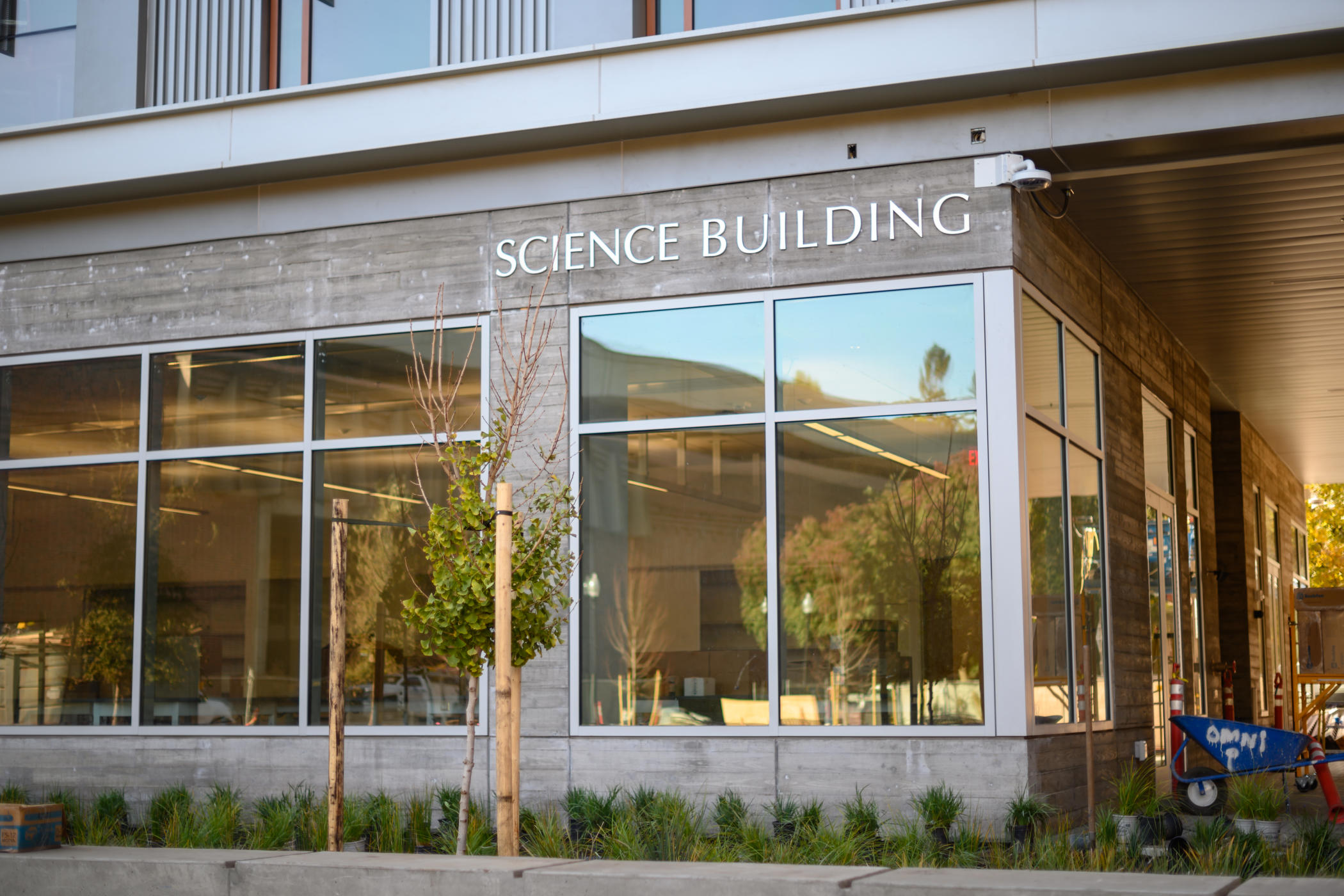
(Jason Halley / University Photography)
Chico State’s Science Building has been heralded as a model for 21st-century learning and sustainability ever since its opening in 2021. As it continues to serve as a model, it recently earned a prestigious Education Facility Design Award from the American Institute of Architects (AIA).
The cutting-edge building, which was designed by the SmithGroup, is not only the newest building on campus but also one of the ambitious buildings within the 23-campus California State University system. In both design and function, it sought to put the sciences on display while integrating them into the core of the physical campus.
“The new Science Building at Chico State represents a crossroad at the historic campus core, helping tie the disparate parts of the campus together, creating a new university gateway,” said Wil Caine, an associate at SmithGroup. “The new building represents a seamless integration of architecture and landscape, celebrating the Chico State campus’ unique setting while tying the distinctive ecological site features directly to the science curriculum.”
The Education Facility Design Award commends the project for how it reconnected disjointed areas of the campus, featuring a large breezeway that acts both as a gateway from the west and an opportunity for outdoor learning. The building’s two wings come together at an angle to represent the literal intersection of the campus community.
The Science Building is home to the Earth and Environmental Sciences, Chemistry, Physics, and Science Education departments. Beyond science majors, students studying education, engineering, agriculture, and other fields take classes in the building and many general education science classes are also held in the Science Building. Many of its classrooms are clearly visible from circulation paths to create an environment that fosters curiosity and interdisciplinary learning.
The building also features undergraduate and graduate research spaces, student conference rooms, faculty offices, and administrative and support areas. In addition, there are many collaborative workspaces for students to gather to brainstorm, work in groups, study, and advance cross-disciplinary projects, as well as dedicated spaces for individual clubs that give students space for tutoring, mentoring, and other projects.
“The building has become a campus hub for learning and curiosity. Faculty use it to create hands-on research and experiential opportunities,” said David Hassenzahl, dean of the College of Natural Sciences. “We had high expectations for the building and couldn’t be more pleased with how it invigorates our students, with active learning going on both in the classrooms and the many informal spaces available to them!”
The award also acknowledges that the design is responsive and respectful of the cultural heritage and values of the Mechoopda Tribe, seamlessly integrating environmental stewardship and teaching opportunities into the architecture and surrounding landscape. An outdoor space called Bahapki Commons honors the Mechoopda village that once stood where the campus sits today. Bahapki was a Mechoopda village on the banks of Big Chico Creek where the campus is today.
Designed for energy efficiency, the 110,200-square-foot facility is certified LEED Gold by the US Green Building Council rating system. Its features include a sizable rooftop solar panel array, reflective panels, roof membranes, insulation, daylight optimization, shading, and sunscreens. An intricate system of chilled beams also provides efficient cooling for laboratory spaces. Outside, the Science Building uses two bioswales (also referred to as rain gardens) and four flow-through planters to prevent stormwater runoff into neighboring Big Chico Creek. Instead, disconnected downspouts divert rooftop water to the bioswales and native planters along its perimeter, which restores natural watershed processes and filters metals and organic contaminants.
This Education Design award program is sponsored by the Committee on Architecture for Education, an AIA Knowledge Community. Recognized projects represent state-of-the-art learning environments, including early childhood, K-12, alternative, community and technical colleges, schools of higher education, corporate or other specialized training centers, and non-traditional learning environments such as community centers, museums, libraries, nature centers, and interpretive centers.
###
About Chico State
At Chico State, we empower students to Do and Dare in their careers and lives. Founded in 1887, Chico State is the second-oldest institution in the 23-campus CSU, the nation’s largest public university system. Chico State enrolls approximately 14,000 students and serves as the comprehensive university of the North State, the 12-county region where the campus is located. A 20-time US News & World Report “Top Public School in the West,” Chico State prides itself on its high-quality, high-value education, an active and engaged student body, and strong connection with the local community and state of California. Recognized for its focus on sustainability and community involvement, students expand their possibilities through more than 380 academic offerings and co-curricular programs and work closely with expert faculty to devise solutions for the unprecedented global challenges of the 21st century.
Contact Information:
Andrew Staples
ajstaples@csuchico.edu
650-269-3126
